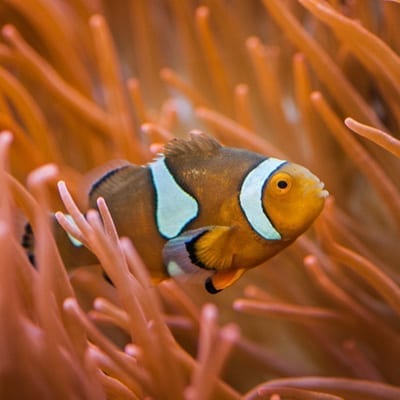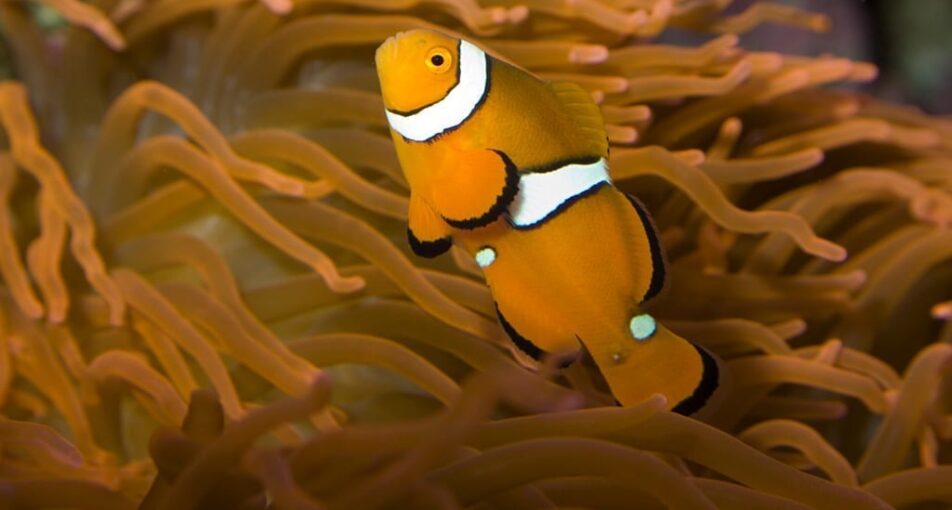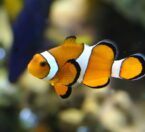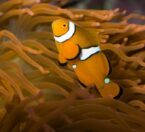Clownfish have adapted to life on the reef by developing a symbiotic relationship with the anemones. Clownfish are small and would be preyed upon by larger fish if they were not living within and protected by the stinging tentacles of the anemone. The clownfish is covered with a specialized mucous that gives it immunity from the sting cells on the host anemone. Safe within the anemone tentacles, the clownfish can feed on planktonic organisms that float by.
Classification
| CLASS: | Osteichthyes |
| ORDER: | Perciformes |
| FAMILY: | Pomacentridae |
| GENUS: | Amphiprion |
| SPECIES: | percula |
Habitat & Range
This genus of fish inhabits shallow sunlit tropical reefs with an abundance of anemones. Here the depth rarely exceeds 39 feet (12 m) and water temperature ranges between 77-82.4 Fo (25-28 Co).
Clownfish are native to the warm waters of the Indian and Pacific Oceans including the Great Barrier Reef and the Red Sea.
Location


Adaptations
- Anemones Depend on Clownfish
- The symbiotic relationship between clownfish and anemones also benefits the anemone. The clownfish drives away hungry butterfly fish that would nibble on the anemone’s tentacles. The clownfish also “preen” the anemone’s tentacles by cleaning up the leftovers, waste material and debris that might clutter up the anemone and invite parasites and algae. The clownfish also draws potential prey into the tentacles where it is stung and eaten by the anemone.
- Clownfish Depend on Anemones
- Clownfish have adapted to life on the reef by developing a symbiotic relationship with the anemones. Clownfish are small and would be preyed upon by larger fish if they were not living within and protected by the stinging tentacles of the anemone. The clownfish is covered with a specialized mucous that gives it immunity from the sting cells on the host anemone. Safe within the anemone tentacles, the clownfish can feed on planktonic organisms that float by.
Physical Description
- Clownfish are up to three and a half inches (8.9 cm) long.
- They most often have color patterns in orange, red or black with white bars or patches.
- Their bodies are covered with scales.
- They have fins and gills.
Diet
What Does It Eat?
In the wild:
Algae, invertebrates and planktonic organisms.
At the zoo:
Mysis shrimp, algae and flake fish food.
What Eats It?
Other larger fish prey on all species of clownfish.

Social Organization
Clownfish live in small groups inhabiting a single anemone. The group consists of a dominant breeding pair cohabiting with a few non-reproductive adult and juvenile clownfish. They aggressively defend their territory, bullying others away from their host anemone.
Life Cycle
Within a small group of clownfish only the dominant male and female clownfish mate. The female then lays 300-700 eggs on the rocky area beneath the host anemone. The eggs are cared for by the male who routinely fans them, circulating the water and increasing the oxygen supply. He cleans away debris and mouths the eggs, removing any dead eggs. The eggs hatch at night after six to seven days of incubation. The offspring, called “fry,” are all male and they are tiny (one-tenth inch or 3-4 mm). The clownfish fry float away, joining the plankton that travels with the ocean currents. After 15 days of floating, eating and growing, they are ready to bond with a host anemone. Juvenile clownfish live and feed mainly around the fringes of an anemone’s tentacles. If the breeding female dies, the adult male has the biological ability to change sex and over a couple of weeks, become a female. Meanwhile the biggest of the juvenile males steps up to replace the breeding male and they form a new breeding pair. This unique adaptation ensures the continuation of the species. The lifespan of clownfish is unknown.











